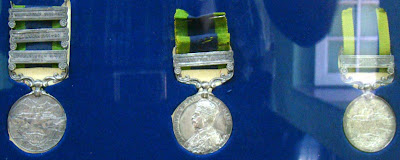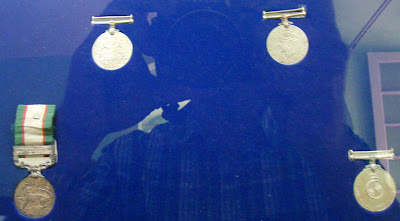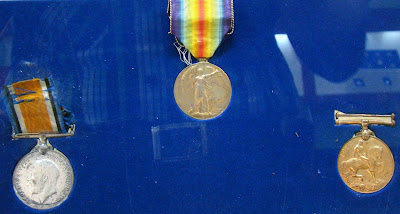Did you know Series (15) : Fort St. George, Chennai Museum (Part I):
i)The advent and early days of the East India Company in India and
the History of Fort St. George at Madras (Chennai)
ii) British Raj Medals, Porcelain of East India Company and the
Nawabs of Arcot, and selected other memorabilia
My wife Sumita and I spent Christmas vacations in December 2012 with our friend Ajit George in Chennai.
Having read so much about Fort St. George's contribution to Indian coinage history and the Madras mint(s) , I was naturally inclined to visit the Fort Complex which, inter alia, houses the Government Secretariat and the Fort Museum.
Ajit willingly took us to the Museum, where a Treasure trove of East India Company and other memorablia was unfolded before us. I have tried to capture what we saw in this three part blog-post .
i)The advent and early days of the East India Company in India :
-
On 31.12.1600 Queen Elizabeth I granted exclusive trading
rights in the East to the East India Company through a Royal Charter.
-
On 24.08.1608 Eight years later, the first ship fitted out by
the East India Company landed in India off the coast of Surat.
-
In 1612, the first factory was built at Surat which was a
fortified ware-house. The East India Company found the initial years difficult,
as the local authorities under the influence of the other European traders were
hostile towards the English. The English were keen to start trading in painted cloth (
as well as Indian calico) and Indian spices for which there was a ready market
in Europe and profit margins were much higher. Painted cloth had designs drawn
in colour by hand on varieties of cotton fabrics which never faded away. The
best painted cloth was made in present day Andhra Pradesh and the Northern
coast of present day Tamil Nadu.
-
Guided by business considerations,
the East India Company began searching for footholds on the Eastern coast and
built a fugitive lodgment at a location in modern day Nizamapatnam, which was
abandoned in a decade’s time.
-
The Company meanwhile, secured Trading Rights north of Masulipatnam
with the Nizam of Golconda. They landed in trouble soon thereafter with the
local authorities. In 1626, the East India Company was allowed to fortify a
small land in Armagon (present day Durgarayapatnam), north of Pulicat Lake. The
Dutch who had arrived earlier and had a settlement at Pulicat objected to their
presence and hindered them at every step.
-
The East India Company was
forced to retreat to Masulipatnam on the assurance of better terms there, which
were not forthcoming.
-
Francis Day, the Chief Factor of
the East India Company recognized the need for an ideal location which could
procure and supply quality cloth, as well as helpful local contacts and no
interference from the authorities and other European Powers/Traders. He took permission
from the Chief Agent of the Company to explore other sites along the coast on
the South, so that Armagon could be closed.
-
Day sailed south from Armagon. He
met Damarla Venkatappa Nayaka in July 1639, a noble under Venkatdri Nayak, the Vijayanagar
ruler of Chandragiri and controlling Regions around Madraspatnam (later Madras
and present day Chennai). Day was convinced about the favourable location of a
Trading Post at Madras for the East India Company and worked out favourable
terms with the Nayaks for the East India Company.
-
He made a strong recommendation
to the Agent and Factors at Masulipatnam for shifting the Trading Post from
Armagon to Madraspatnam near Santomay (Santhome – a suburb 5 km South of Fort
St. George by stating that the terms were extremely favourable and economical
for carrying out the East India Company trading activities as well as the terms
of the “Firman” (Royal Charter/Edict) proposed to be issued by the Nayak ruler.
Establishment and Brief History of the Fort St.George at
Madras:
(A Painting of Fort St. George at Madras (present day Chennai) on display at the Museum Art Gallery situated in the Fort complex. Notice that several sailing ships have been depicted in the painting).
-
After several parleys between
the East India Company officials on Francis Day’s recommendations, ultimately
approval was granted to Day’s proposal) and on 20.02.1640, Andrew Cogan and Francis Day landed on the beach
where the construction of Fort St. George was proposed by them.
-
On 01.03.1640, the construction of the Fort began in right
earnest which was completed in 13 years. The Fort had a Governor’s residence at
the Centre, surrounded by the “White Town” for the English and other Europeans,
while the native traders and traders lived in the “Black Town”.
-
In 1680, the St. Mary’s
Church was built, which is today the oldest surviving building within
the Fort. The construction of St.
Mary’s Church was funded by public contributions through a concept
mooted by the then Governor of Fort St. George.
-
The new Fort House was built by pulling down some old buildings (It
forms the nucleus of the present Government Secretariat – present day). The
“Grand House on Charles Street”, Clive’s House and some other buildings were
constructed in early 18th century. A 1710 map available even today
also shows a private Mint, a hospital, a storehouse, a Town Hall (next to St.
Mary’s Church, besides mentioning the names of roads within the Fort and in the
“Black Town”.
-
In September 1746 the French captured and occupied Madras till August
1749 demolishing the “Black Town” in order to form a glacis. Muthialpet
and Peddanaickenpet located about two Km. from the Fort became the new Black
Town.
-
The East India Company
subsequently regained possession of the Fort and during 1755 to 1783, strengthened the defences by
constructing several structures which led to give the Fort its present shape.
-
As a preliminary measure in 1755, the King’s Barracks were
built to accommodate the bachelor officers and ranks of the East India Company
Army. A Grand Arsenal was
added to store the ammunition required for the Carnatic Wars and some private
property was acquired to build barracks for the soldiers.
-
In 1756 to expand the Fort, the small Elambore River flowing as
the Western defence was diverted by filling Earth. The massive quantity of
Earth was obtained by leveling the natural mound called “Hog’s Hill” (Narimedu)
located further West. Cisterns were built to support water requirements for
about 6000 men.
-
In 1795, the Exchange Building was completed where the first
Lighthouse of Madras was positioned to warn of night attacks from the enemy.
-
When completed, Fort St. George
was spread over 42 acres inside and over 60 acres outside the Fort Walls. The
Fort had 3 principal gates, the “Sea Gate”, which has now been closed, the
“Wallaja Gate” and “St. George Gate” apart from a few minor gates. The Gates
were further strengthened by bastions, ravelins flanked by lunettes. A wet
ditch was built all around the Fort as an added security measure.
-
The “Fort House”, the seat of Governance from the very beginning
was built at the present location in 1640 and rebuilt in 1693 and several
renovations later still houses the Government Secretariat.
-
Among other buildings “The Exchange Building” located
near the Sea Gate was built between 1790 and 1795. It is interesting to note
that the entire cost of construction was met from profits from conducting
lotteries. This building was the hub of all trading activities and was open to
all merchants, dealers and commanders of ships and any other person interested
in trading of goods. Later this building was converted into the Officer’s Mess
for the Fort’s garrison. Clive’s
House ( also referred to as “Admiralty
Building” or “The Great House
in Charles Street” was opened by an Armenian merchant in early 18th
century and later, the English acquired it for renting it out to important
dignitaries of the East India Company including Col. Robert Clive, hence the
name. The Long Hall in the building was used for banqueting by the Governors
and the building was used for holding courts to deal with interlopers which
earned it the name “Admiralty Building”.
-
Another interesting history of the fort remnants are many streets
some of which are still addressed with their old names. For example, Clive’s
House and the Grand Arsenal are located on the “Charles Street”. Also,
initially, with the advent of the East India Company, several Europeans from
Armenia, Portugal, etc. pitched in their lot with the Company for trading
purposes and purchased properties in the northern portion of the Fort, while
the East India Company Englishmen and Traders populated the Southern portion of
the Fort. Gradually, all the European properties were purchased by the East
India Company by the nineteenth century. Some of these residences are still preserved
in a row behind the Fort museum and exhibit storerooms and servant’s quarters
on the ground floor while the owners lived on the upper storey, presumably to
store goods for trade and easy distribution to the purchasers/buyers.
Some tit-bits about Fort St. George:
-
Fort St. George is a miniscule fort as
compared to several impregnable Forts in India. The Fort is named after St.
George who is the patron Saint of England.
-
Since inception of the Fort,
the East India Company, being primarily a Trading Company followed the policy
that “War is bad for Trade”. In spite of several incursions by marching armies,
Madras held on to its flourishing trade with a relatively small army.
-
Fort St. George was the birth-place
of several institutions:
a) It had a meticulous system of filing all records of
transactions at the Fort. This practice was followed by all offices of
the East India Company and several Government Departments in Independent India.
b)
Its acquisition of properties
around the Fort area laid the
foundation of a “mega-city” (present Chennai is one of the Five
Metropolitan cities in India, as a result of these initiatives).
c)
The delivery of Justice was done by a “Choultry Court” and the
“Admiralty Court”, again a first step towards establishing a judicial system in
India. The oldest surviving Anglican Church (St. Mary’s Church was built in
Fort St. George. The first constabulary, hospitals, mint and other civic
amenities were established in the Fort.
d)
Having seen the efficacy of
native soldiers under the command of French officers in the brief capture and
occupation of Fort St. George, the English emulated this practice and the First modern unit of the East India
Company Indian Army, the 1st Madras Europeans was created,
which acquitted itself with valour and victory in campaigns all over India, by
putting Native soldiers under the charge of competent British officers. Fort
St. George was never seriously threatened thereafter.
e)
Its heritage rests on its contribution to shape the institutions
of Modern India.
The approach to the Museum at Fort St. George, Chennai. Don't miss the placard proclaiming "York Street" one of the British Period road names still retained as Heritage memorablia.
The Museum is situated in the erstwhile Exchange Building. The "Open Book" information panel mentions inter-alia, that the "Long Hall was used as an Exchange but also served for Public Meetings Lottery Drawings and occasionally for entertainments. The Apartments on the ground floor were employed as Auction Rooms, the Library and for the Madras Bank".
Exhibits of the Commemorative Medals Awarded by the British in India:
A replica of the Victoria Gold Medal dated 1st January 1877.
This Victoria Gold Medal was issued to commemorate the event of proclamation of Queen Victoria as the Empress of India in 1877. This series of medals was also issued in Silver - Gold Medals for the Rulers of Indian States and silver for prominent officials.
The Medals on the Obverse showed the Portrait of Queen Victoria with the legend "Victoria 1st January 1877".
The Reverse had "Empress of India" mentioned in English, Persian and the Devanagari scripts. In the Devanagari script she was called "Hind ka Kaiser".
This placard mentions that the Indian General Service Medal was instituted on 23rd January 1854 to commemorate the campaign in Burma and was awarded till 1895.
Some Indian General Service Medal specimens:
As mentioned in this placard, the India Medal ("Bhartiya Padak" in Hindi) was instituted in 1896 as the successor to the India General Service Medals, and was awarded till 1902 . This medal was awarded for distinguished Service in the North West Frontier Operations.
Some India Medal specimens:

India General Service Medals were again awarded from 1908 to 1935. These Medals were issued by Edward VII and George V for distinguished Service in various campaigns in India.
Some India General Service medals specimens awarded during this series :
The following are some of the World War I and II Medals:
Other Medals issued for events in India specimens:
Coat of Arms the East India Company in the 17th Century:
Porcelain of the East India Company displaying a later emblem or Coat of Arms of the East India Company:
The following images are from the tableware of the Governors of the East India Company, characterised by the logo/emblem of the Company. The porcelain includes large oval and square dishes, perforated plates, dishes with lids, fruit bowls and large meat plates with lids. Some dishes have a chamber at the bottom to take hot water, so as to keep the food warm. Most of these dishes were imported from Britain.
The following images are from the tableware of the Governors of the East India Company, characterised by the logo/emblem of the Company. The porcelain includes large oval and square dishes, perforated plates, dishes with lids, fruit bowls and large meat plates with lids. Some dishes have a chamber at the bottom to take hot water, so as to keep the food warm. Most of these dishes were imported from Britain.
The following images are of Porcelain used in the official functions of Governors of East India Company at Fort St. George, Madras:
This crockery also exhibits the Coat of Arms of the East India Company.
The following images are of 20th Century Porcelain Memorablia :
A coffee mug showing a profile of King Edward VII facing left with the motto "Dieu Et Mon Droit". Such mugs and commemorative plates like the one given below, were manufactured at the time of Coronations of the British monarchs.
A porcelain plate showing George V King Emperor with his Royal consort Queen Mary.
Flower vases of Worcester Porcelain from 1800 A.D. showing the East India Company Emblem.
Porcelain of the Arcot Nawabs:
These Porcelain pieces are from the personal ware of the Nawabs of Arcot. The porcelain carries their Names in the Persian script. The shapes of dishes are typically Islamic, with circular plates of various sizes, bowls, spoons and fruit bowls.
Silverware used in St. Mary's Church in the 1600s during the period after its construction:
Locks and Keys of the Gates of Fort St. George used in the 18th Century:
Specimen of a Mortar used by the East India Company/British armies.
A Grape-shot used in Cannon/Mortars to clear the decks in Sea- battles and to attack the Ramparts/ fortifications in land battles.
This placard shows images of Grape-shot, cannon shot and chain-shot together with an illustration of how a grape-shot fired with precision could wreak havoc in the enemy defences.
A cannon from Sindh.
Small cannon used during Quick marches.
A Maratha cannon.
Battle weapons.
A chart displaying the three types of guns/pistols used in battle - Matchlock, Flintlock and Percussion lock.
Catching up with Marquis Cornwallis "Governor General and Commander in Chief of all the Forces in India" and apprising that La Martiniere College Lucknow (established in 1845), where I have studied in the 1970s has a House named after him.
i)For Part II of this article which includes "Coins of the Madras, Bengal and Bombay Presidencies , the Mughals, the Southern Kingdoms - the Nayaks, Travancore State and Mysore Kingdom, Tippu and Nawabs of Arcot etc. , please click on the Link below:
ii) For Part III of this article which includes "Indo-French, Indo-Portuguese, Indo-Dutch, exchange values of coins in use in India during the seventeenth and eighteenth centuries, Mints in India during the seventeenth and eighteenth centuries etc), please click on the undernoted link:
iii) For Ancient coin minting Moulds,ancient Chinese, Indian and Islamic coins at Shanghai Museum, please click on the undernoted link:
iv) For an interesting coverage of our recent trip to Chennai, please click on the undernoted link:




























































 ,
,









Ramchandra Lalingkar commented on 08.01.2013:
ReplyDelete"What an exhaustive, informative article with number of photographs !! Commendable writing indeed !!"
Thank you so much for your constant encouragement and guidance.
ReplyDeleteVineeta Jain commented on 09.01.2013:
ReplyDelete"Hi rajeev!! Enjoyed going thru the account....loved the museum pics especially the lovely crockery!!!!"
Thanks. The Porcelain crockery and silverware from the 17th and 18th centuries at the Museum are indeed a Treat.
ReplyDeleteI actually enjoyed reading through this posting.Many thanks.
ReplyDeleteHome Renovations Chennai
Thank you, Shyam.
Deletei want know more about maratha cannons
ReplyDeleteنقدم لكم ارخص معارض اثاث مكتبي فى مصر يقدم المعرض مجموعة متنوعة من الاشكال لغرف المكتب او لغرفة الاجتماعات التي يجب ان تتكون متوفرة في كل الشركات و الوسسات الكبيرة و الصغيرة .
ReplyDeleteThank you for sharing this great post. It’s really very nice to read. We deal with All types of lights, LED Lights, Indoor Lights, Outdoor Lights, Chandlier Lights, and also specialize in Ceiling Lights.
ReplyDelete